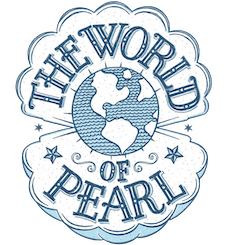 Why does your grandmother have graduated pearls? Graduated pearls were very in style in the 1940s and 1950s in the U.S. Ever wonder why? I used to sell graduated pearls because they are not very easy to find any more. And, truthfully, they were not easy to sell but trends have shifted again and now The Pearl Girls Graduated Pearl Necklaces are popular again! Check our necklace out here: https://devtpg.wpengine.com/shop/graduated-pearl-necklace/
Why does your grandmother have graduated pearls? Graduated pearls were very in style in the 1940s and 1950s in the U.S. Ever wonder why? I used to sell graduated pearls because they are not very easy to find any more. And, truthfully, they were not easy to sell but trends have shifted again and now The Pearl Girls Graduated Pearl Necklaces are popular again! Check our necklace out here: https://devtpg.wpengine.com/shop/graduated-pearl-necklace/
These days many women opt for the fuller look of a 7mm pearl strand versus one that, let’s say, starts with a central 7mm pearl and progressively gets smaller towards the clasp. All graduated necklaces can vary in size but a very common size starts with a central 7-8mm pearl and graduates to a smaller 3-4mm size so the necklace flows evenly from small to large and back to small again. Of course, you can also find graduated pearls in a variety of pearl sizes. Our current offering starts with a Large 10mm pearl… which might be why it is more popular. It offers a beautiful “pop.”
Creating this type of necklace is labor intensive. It is much easier to match a strand of 7mm pearls rather than match a pearls progressively smaller along a necklace.
Let’s take a look at history. Mikimoto created his first spherical cultured pearl in Japan in 1905. The cultured pearl industry really began to boom after that point, however, there was an economic fallout related to the Great Depression, increasing conflicts with Manchuria and China and, of course, Japan entered into war with the U.S. in 1941.
In 1938 there were 360 active cultured pearl farms in Japan producing almost 11 million akoya cultured pearls. As hard as it might be to imagine, there were still limited quantities of Japanese akoya cultured pearls so creating uniform strands of pearls was close to impossible. So, the graduated strand of pearls was born. This marked an easy way to create a stylish pearl necklace that was not dependent on a full strand of identically sized pearls. Almost all cultured pearl strands knotted before the 1950s was a graduated strand.
Talk about troubles, World War II devastated the cultured pearl market in Japan. Allied forces occupying Japan after the war were concerned about an illegal cultured pearl trafficking so they actually discouraged the sale of cultured pearls within Japan. To counterbalance this restriction, the Japanese instead sold pearls in military stores frequented by Allied troops.
And the Americans came home with pearls! American troops and servicemen bought thousands of graduated cultured pearl strands and brought them home to their loved ones. This kept the Japanese cultured pearl trade going and it really sparked the beginning of the popularity of cultured pearls in the U.S.
And that is why your grandmother has a graduated strand of cultured pearls!
What happened next? See my next post… Japanese pearls after WWII
I am a modern day treasure hunter who travels the world for gorgeous pearls and amazing adventures. I own a pearl jewelry and jewelry repair business, ThePearlGirls.com, with a cute retail store in Athens, GA. I also have a Pearl Travel business and travel blog at TheWorldofPearl.com.



Agree with your comments on graduated pearls. Still think they are classic. Where can I buy.
Helen! We now offer Graduated Pearl Necklaces on sterling silver chain! Check them out here: https://devtpg.wpengine.com/shop/graduated-pearl-necklace/ We also make full strands as custom orders and we have had so many requests for them, we are going to incorporate them into our regular offerings! Stay tuned!
Best,
India
Is it possible to “date” a particular strand? I have a vintage Mikimoto graduated pear necklace. The strand has the original Mikimoto clasp, is in the original Mikimoto box, and they are in pretty much perfect condition. (The box does show some wear from being old.) We plan to take them to the local jeweler for appraisal so we can be sure they are insured correctly (ins company is requiring appraisal paperwork) but I want to be knowledgeable about what I have before I take what the jeweler says “at face value.” I’m concerned the jeweler may not be familiar with Mikimoto and how old the necklace is.
Hi Janai! It is true the jeweler may not be familiar with Mikimoto pearls and I completely understand your concern. I imagine, or it is my hope, that the appraiser will be able to give you an accurate value of your pearls and they will be able to do this without knowing the date of the pearls. Obviously, as you read in my post, the graduated style was born out of necessity. There simply were not enough pearls to create a strand with perfectly matched pearls. As the pearl industry grew and more pearls were available, we shifted into strands of the same size of pearls. But, that does not mean the graduated strands suddenly went out of fashion. Even today you can find graduated strands although they are certainly not as popular as they used to be. Pinpointing the exact date would be difficult for me. Do you have any idea or can you figure out the date judging by where and when they came from? I wish I could date them for you and if I ever come across someone who can I will definitely let you know! Let me know if I can be of further help!
Best,
India